Use Docker Desktop Enterprise on Mac
Estimated reading time: 14 minutesThis page contains information about testing the installation and configuring Docker Desktop Enterprise (DDE) runtime options on Mac.
Test your installation
-
Open a command-line terminal and test that your installation works by running the simple Docker image, hello-world.
$ docker run hello-world Unable to find image 'hello-world:latest' locally latest: Pulling from library/hello-world ca4f61b1923c: Pull complete Digest: sha256:ca0eeb6fb05351dfc8759c20733c91def84cb8007aa89a5bf606bc8b315b9fc7 Status: Downloaded newer image for hello-world:latest Hello from Docker! This message shows that your installation appears to be working correctly. ... -
Start a Dockerized web server. Like the
hello-worldimage above, if the image is not found locally, Docker pulls it from Docker Hub.$ docker run --detach --publish=80:80 --name=webserver nginx -
In a web browser, go to
http://localhost/to view the nginx homepage. Because we specified the default HTTP port, it isn’t necessary to append:80at the end of the URL.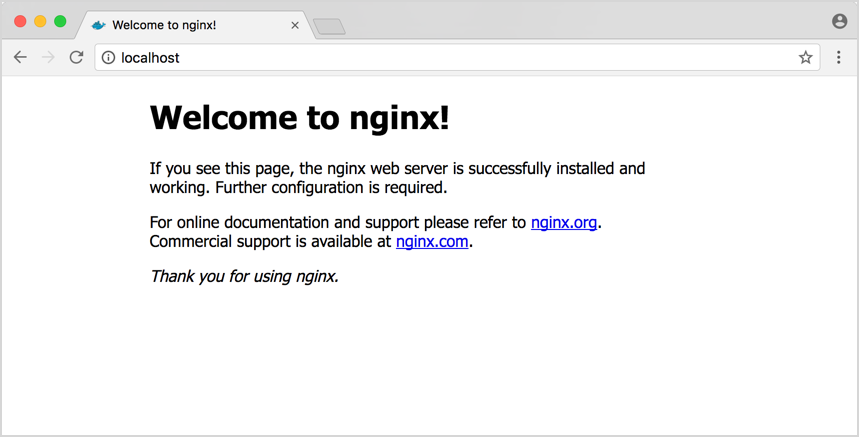
-
View the details on the container while your web server is running (with
docker container lsordocker ps):$ docker container ls CONTAINER ID IMAGE COMMAND CREATED STATUS PORTS NAMES 56f433965490 nginx "nginx -g 'daemon off" About a minute ago Up About a minute 0.0.0.0:80->80/tcp, 443/tcp webserver -
Stop and remove containers and images with the following commands. Use the “all” flag (
--allor-a) to view stopped containers.
$ docker container ls
$ docker container stop webserver
$ docker container ls -a
$ docker container rm webserver
$ docker image ls
$ docker image rm nginx
Docker Desktop user interface
The Docker Desktop Enterprise user interface provides options to configure Docker Desktop preferences such as installation, version packs, Docker Hub login, and more. Right-click the Docker icon from the menu bar to open the Docker Desktop user interface.
Version Selection
The Version Selection option lists the version packs installed on your Docker Desktop environment and allows you to switch between Docker Engine and Kubernetes versions using a single click. When you select a different version pack, Docker Desktop restarts and the selected versions of Docker Engine and Kubernetes will be used.
To switch to a different version pack, simply click on the version pack you would like to use.
Preferences
Click on the Docker icon from the menu bar and then Preferences to configure the runtime options described below.
Note: Administrators have the ability to lock some configuration options. Locked options cannot be selected, and are displayed with a lock icon.
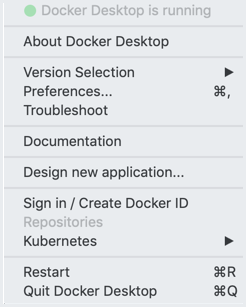
General
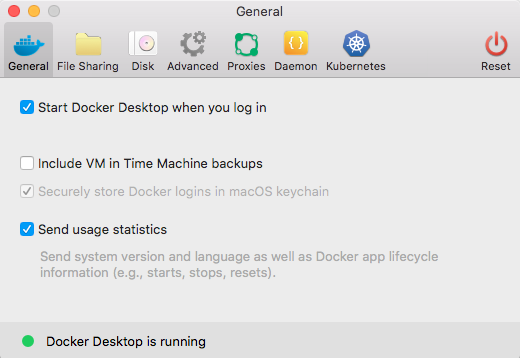
General settings include:
-
Start Docker Desktop when you log in: Starts Docker Desktop when you open your session. (Enabled by default)
-
Include VM in Time Machine backups: Backs up the Docker Desktop Enterprise virtual machine. (Disabled by default)
Securely store Docker logins in macOS keychain: Stores your Docker login credentials. (Enabled by default)
-
Send usage statistics: Sends diagnostics, crash reports, and usage data to Docker. This information helps Docker improve the application and get more context for troubleshooting problems. (Enabled by default)
File Sharing
Choose which local directories to share with your containers. File sharing is
required for volume mounting if the project lives outside of the /Users
directory. In that case, share the drive where the Dockerfile and volume are
located. Otherwise, you get file not found or cannot start service errors at
runtime.
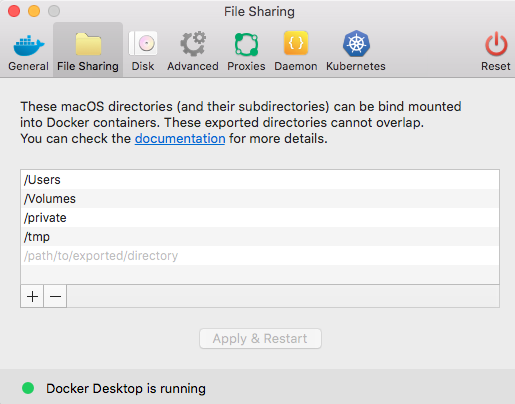
File sharing settings include the following options:
-
Add a Directory: Click
+and navigate to the directory you want to add. -
Apply & Restart makes the directory available to containers using Docker’s bind mount (
-v) feature.There are some limitations on the directories that can be shared:
- They cannot be a subdirectory of a directory that has been shared already.
- They cannot already exist inside of Docker.
For more information, see:
Disk
Specify the Disk image location of the Linux volume, where containers and images are stored.
You can also move the disk image location. If you attempt to move the disk image to a location that already has one, you get a prompt asking if you want to use the existing image or replace it.
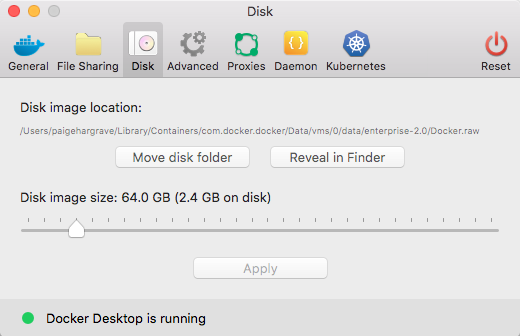
Advanced
On the Advanced tab, you can limit resources available to Docker.
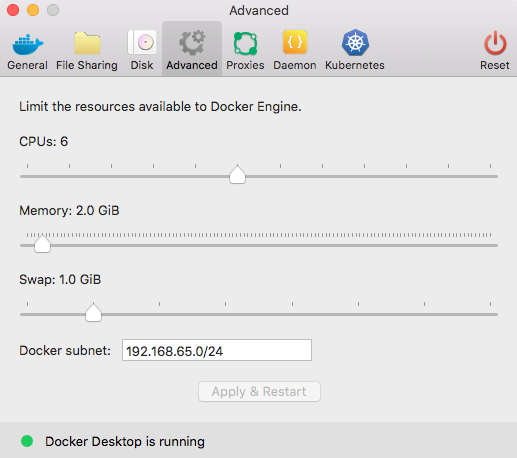
Advanced settings include the following options:
-
CPUs: By default, Docker Desktop Enterprise is set to use half the number of processors available on the host machine. To increase processing power, set this to a higher number; to decrease, lower the number.
-
Memory: By default, Docker Desktop Enterprise is set to use 2 GB runtime memory, allocated from the total available memory on your Mac. To increase RAM, set this to a higher number; to decrease it, lower the number.
-
Swap: Configure swap file size as needed. The default is 1 GB.
Proxies
Docker Desktop Enterprise detects HTTP/HTTPS Proxy Settings from macOS and automatically
propagates these to Docker and to your containers. For example, if you set your
proxy settings to http://proxy.example.com, Docker uses this proxy when
pulling containers.
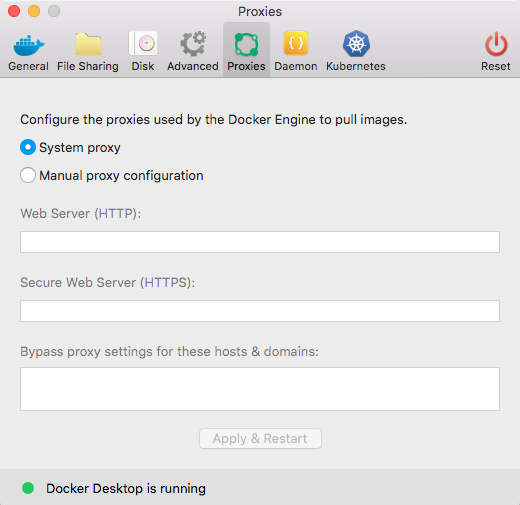
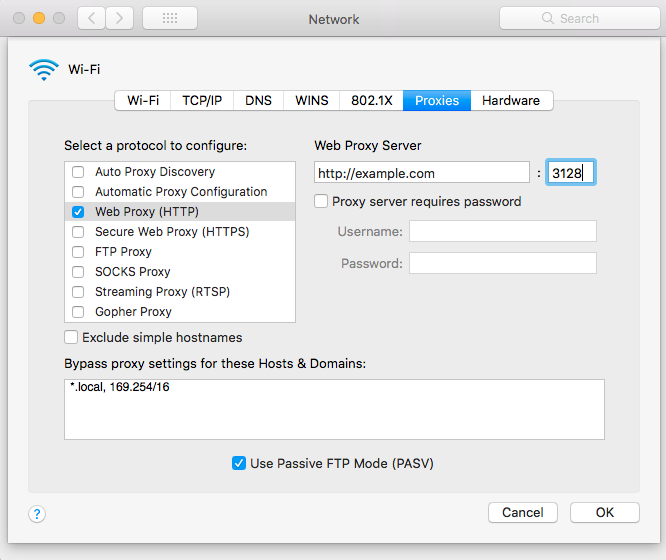
When you start a container, your proxy settings propagate into the containers. For example:
$ docker run -it alpine env
PATH=/usr/local/sbin:/usr/local/bin:/usr/sbin:/usr/bin:/sbin:/bin
HOSTNAME=b7edf988b2b5
TERM=xterm
HOME=/root
HTTP_PROXY=http://proxy.example.com:3128
http_proxy=http://proxy.example.com:3128
no_proxy=*.local, 169.254/16
You can see from the above output that the HTTP_PROXY, http_proxy, and
no_proxy environment variables are set. When your proxy configuration changes,
Docker restarts automatically to pick up the new settings. If you have
containers that you wish to keep running across restarts, you should consider
using restart policies.
Daemon
You can configure options on the Docker daemon that determine how your containers run.
Select Basic to configure the daemon with interactive settings, or select Advanced to edit the JSON file directly.
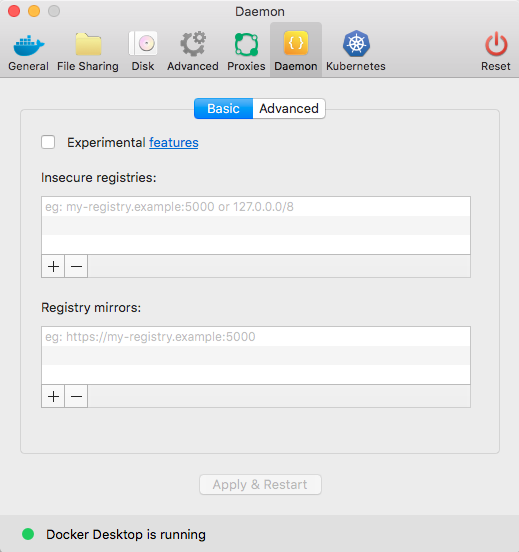
Experimental features
Docker Desktop Enterprise has experimental features enabled on Docker Engine, as described in Docker Experimental Features Readme. If you don’t select Experimental Features, Docker Desktop Enterprise uses the current generally available release of Docker Engine.
Experimental features provide early access to future product functionality. These features are intended for testing and feedback only as they may change between releases without warning or can be removed entirely from a future release. Experimental features must not be used in production environments. Docker does not offer support for experimental features.
To enable experimental features in the Docker CLI, edit the
config.jsonfile and setexperimentalto enabled.To enable experimental features from the Docker Desktop menu, click Settings (Preferences on macOS) > Command Line and then turn on the Enable experimental features toggle. Click Apply & Restart.
For a list of current experimental features in the Docker CLI, see Docker CLI Experimental features.
You can see whether you are running experimental mode at the command line. If
Experimental is true, then Docker is running in experimental mode, as shown
here. (If false, Experimental mode is off.)
$ docker version -f {{.Server.Experimental}}
true
Insecure registries
You can set up a custom and insecure registry to store your public or private images (instead of using Docker Hub or Docker Trusted Registry. Add URLs for your insecure registries and registry mirrors on which to host your images.
For more information, see:
Daemon configuration file
Click the Advanced tab to configure the daemon from the JSON file. For a full list of options, see the Docker Engine dockerd command line reference.
Click Apply & Restart to save your settings and reboot Docker. To cancel changes, click another preference tab, then choose to discard or not apply changes when prompted.
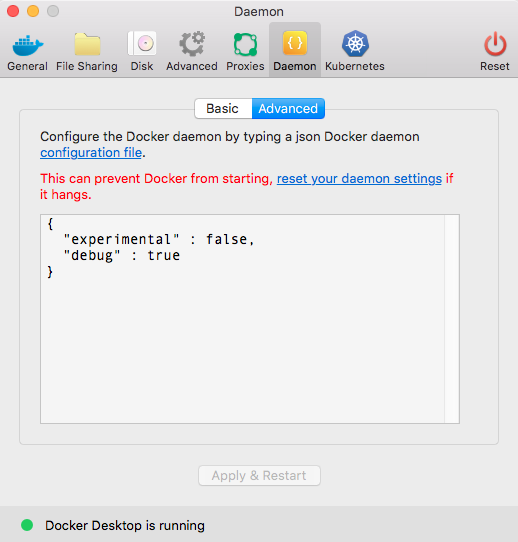
Kubernetes
Docker Desktop Enterprise includes a standalone Kubernetes server that runs on your Mac, so that you can test deploying your Docker workloads on Kubernetes.
The Kubernetes client command, kubectl, is included and configured to connect
to the local Kubernetes server. If you have kubectl already installed and
pointing to some other environment, such as minikube or a GKE cluster, be sure
to change context so that kubectl is pointing to docker-desktop:
$ kubectl config get-contexts
$ kubectl config use-context docker-desktop
If you installed kubectl with Homebrew, or by some other method, and
experience conflicts, remove /usr/local/bin/kubectl.
To enable Kubernetes support and install a standalone instance of Kubernetes running as a Docker container, select Enable Kubernetes, choose the default orchestrator and click the Apply button.
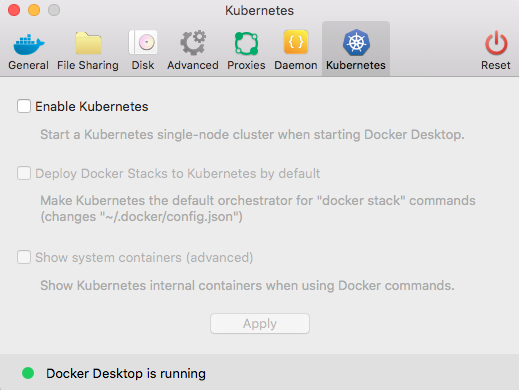
Images required to run the Kubernetes server are downloaded and instantiated as containers, and the /usr/local/bin/kubectl command is installed on your Mac.
When Kubernetes is enabled and running, an additional status bar item displays at the bottom right of the Docker Desktop Enterprise Preferences dialog.
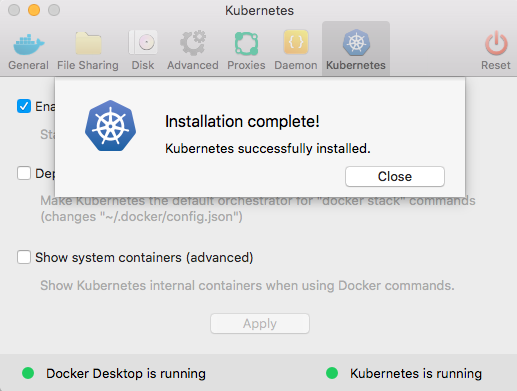
The status of Kubernetes shows in the Docker menu and the context points to docker-desktop.
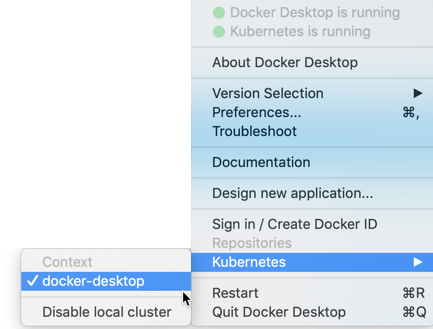
By default, Kubernetes containers are hidden from commands like docker
service ls, because managing them manually is not supported. To view these containers, select Show system containers (advanced) and click Apply and restart. Most users do not have to use this option.
To disable Kubernetes support at any time, clear the Enable Kubernetes check box. The
Kubernetes containers are stopped and removed, and the
/usr/local/bin/kubectl command is removed.
For more information about using the Kubernetes integration with Docker Desktop Enterprise, see Deploy on Kubernetes.
Reset
Click on the Docker icon from the menu bar and then Preferences. Click Reset to reset to factory defaults, restart the Docker daemon, reset Kubernetes cluster, or to reset the disk image.
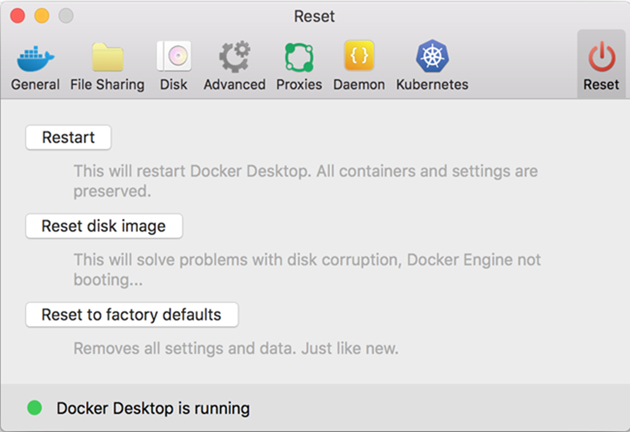
Troubleshoot
The Diagnose and Feedback option allows you troubleshoot any issues you may be experiencing with Docker Desktop Enterprise. For more information, see Troubleshoot DDE issues on Mac.
Design new application
Select this option to open the Application Designer user interface. Application Designer provides a library of application and service templates to help Docker developers quickly create new Docker applications. For more information, see Application Designer.
Docker Hub
Select Sign in /Create Docker ID from the Docker Desktop Enterprise menu to access your Docker Hub account. Once logged in, select Repositories on the Docker Desktop Enterprise menu to access your Docker Hub repositories directly.
See the following Docker Hub topics to learn more:
Add TLS certificates
You can add trusted Certificate Authorities (CAs) (used to verify registry server certificates) and client certificates (used to authenticate to registries) to your Docker daemon.
Add custom CA certificates (server side)
All trusted CAs (root or intermediate) are supported. Docker Desktop Enterprise creates a certificate bundle of all user-trusted CAs based on the Mac Keychain, and appends it to Moby trusted certificates. So if an enterprise SSL certificate is trusted by the user on the host, it is trusted by Docker Desktop Enterprise.
To manually add a custom, self-signed certificate, start by adding the certificate to the macOS keychain, which is picked up by Docker Desktop Enterprise. Here is an example.
$ sudo security add-trusted-cert -d -r trustRoot -k /Library/Keychains/System.keychain ca.crt
If you prefer to add the certificate to your own local keychain only (rather than for all users), run this command instead:
$ security add-trusted-cert -d -r trustRoot -k ~/Library/Keychains/login.keychain ca.crt
See also, Directory structures for certificates.
Note: You need to restart Docker Desktop Enterprise after making any changes to the keychain or to the
~/.docker/certs.ddirectory in order for the changes to take effect.
For a complete explanation of how to do this, see the blog post Adding Self-signed Registry Certs to Docker & Docker Desktop Enterprise.
Add client certificates
You can put your client certificates in
~/.docker/certs.d/<MyRegistry>:<Port>/client.cert and
~/.docker/certs.d/<MyRegistry>:<Port>/client.key.
When the Docker Desktop Enterprise application starts up, it copies the ~/.docker/certs.d
folder on your Mac to the /etc/docker/certs.d directory on Moby (the Docker
Desktop Enterprise xhyve virtual machine).
You need to restart Docker Desktop Enterprise after making any changes to the keychain or to the
~/.docker/certs.ddirectory in order for the changes to take effect.The registry cannot be listed as an insecure registry (see Docker Daemon). Docker Desktop Enterprise ignores certificates listed under insecure registries, and does not send client certificates. Commands like
docker runthat attempt to pull from the registry produce error messages on the command line, as well as on the registry.
Directory structures for certificates
If you have this directory structure, you do not need to manually add the CA certificate to your macOS system login:
/Users/<user>/.docker/certs.d/
└── <MyRegistry>:<Port>
├── ca.crt
├── client.cert
└── client.key
The following further illustrates and explains a configuration with custom certificates:
/etc/docker/certs.d/ <-- Certificate directory
└── localhost:5000 <-- Hostname:port
├── client.cert <-- Client certificate
├── client.key <-- Client key
└── ca.crt <-- Certificate authority that signed
the registry certificate
You can also have this directory structure, as long as the CA certificate is also in your keychain.
/Users/<user>/.docker/certs.d/
└── <MyRegistry>:<Port>
├── client.cert
└── client.key
To learn more about how to install a CA root certificate for the registry and how to set the client TLS certificate for verification, see Verify repository client with certificates in the Docker Engine topics.
Install shell completion
Docker Desktop Enterprise comes with scripts to enable completion for docker and docker-compose commands. The completion scripts may be
found inside Docker.app, in the Contents/Resources/etc/ directory and can be
installed both in Bash and Zsh.
Bash
Bash has built-in support for completion. To activate completion for Docker commands, these files need to be
copied or symlinked to your bash_completion.d/ directory. For example, if you have
installed bash through Homebrew.
etc=/Applications/Docker.app/Contents/Resources/etc
ln -s $etc/docker.bash-completion $(brew --prefix)/etc/bash_completion.d/docker
ln -s $etc/docker-compose.bash-completion $(brew --prefix)/etc/bash_completion.d/docker-compose
Zsh
In Zsh, the completion
system takes care of things. To activate completion for Docker commands,
these files need to be copied or symlinked to your Zsh site-functions/
directory. For example, if you installed Zsh through Homebrew:
etc=/Applications/Docker.app/Contents/Resources/etc
ln -s $etc/docker.zsh-completion /usr/local/share/zsh/site-functions/_docker
ln -s $etc/docker-compose.zsh-completion /usr/local/share/zsh/site-functions/_docker-compose